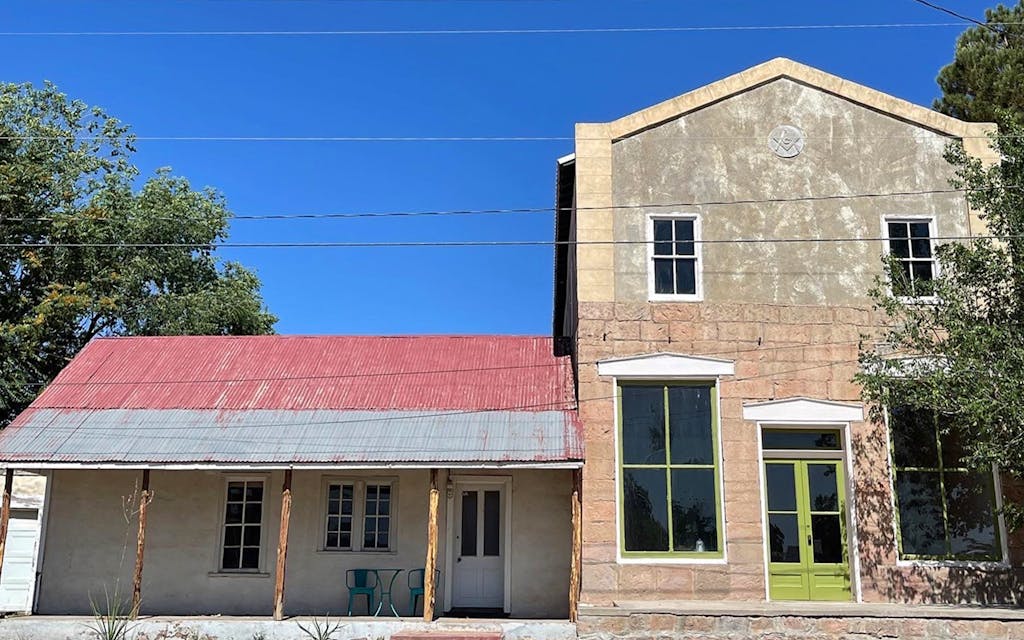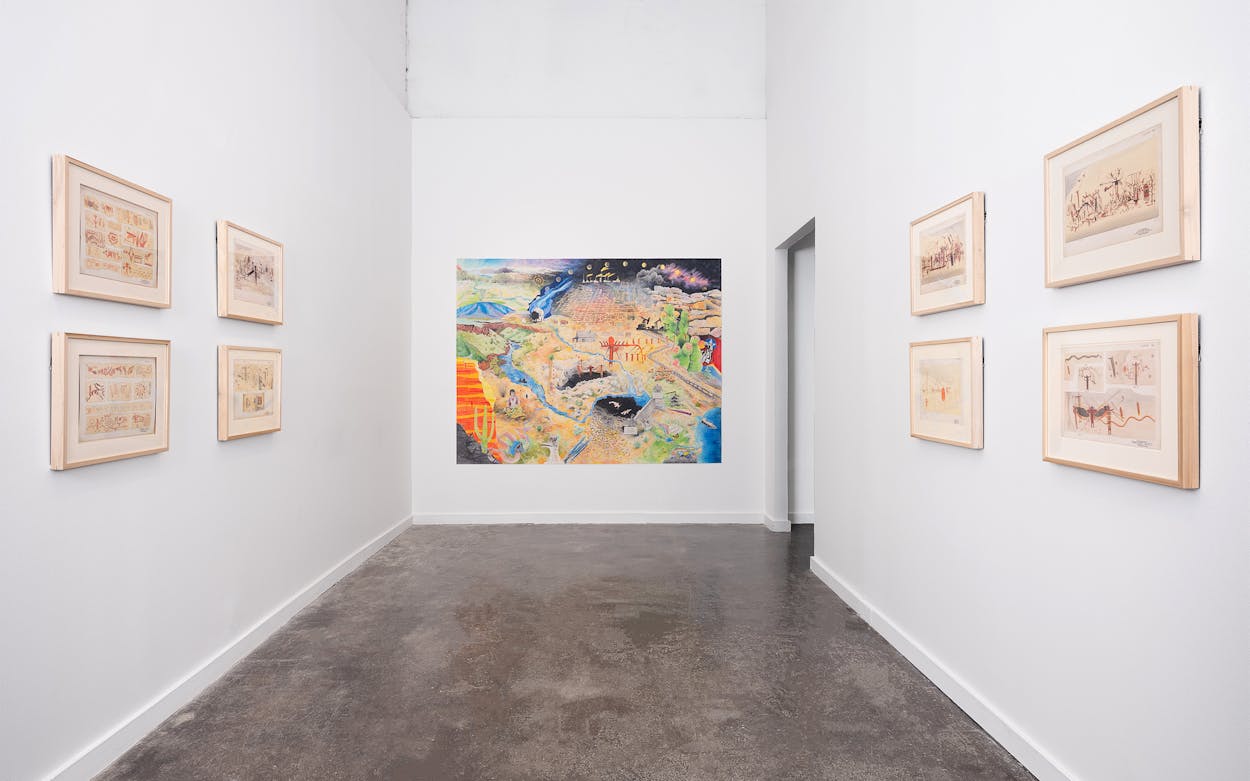Seven out of ten Texans live in the Texas Triangle, the megaregion that includes Austin, Dallas–Fort Worth, Houston, and San Antonio. Those urbanites have many fine museums to choose from, but they’re far from the only Texans with access to world-class exhibits and art spaces. Cultural centers from Albany to Waxahachie offer vast swaths of work from artists of all stripes, some with a special focus on homegrown creators and local history, others with art-world gems from far beyond the state’s borders. Each of the venues below is a destination in its own right, not to mention an in-the-know answer to the question “What’s your favorite museum?”
The Old Jail Art Center
Albany
In 1980, a cluster of moneyed families in a seemingly barren patch of north-central Texas ensured that a tiny, Lonesome Dove–era stone jail did not fall into ruin, but was preserved as an unlikely venue for art. Built by Scottish stonemasons in 1877, the jail has since been expanded and now is one of the most dependably interesting spaces for looking at art anywhere in the state. You can still visit the cramped cells of the original building, but the real thrill of the OJAC is its small-but-mighty, wildly eclectic collection of 2,300 works that span the globe from antiquity to the present day. For temporary exhibits, tireless director and curator Patrick Kelly cherry-picks the choicest contemporary art from Texas. A show at the OJAC is an enviable stamp of approval for artists working here. The Old Jail is also a lively cultural center for locals, with regular programming for families. But even if you don’t live in Albany, at just 125 miles west of Fort Worth, the OJAC is always worth a stop, no matter where you’re headed. —Rainey Knudson
Art Museum of Southeast Texas
Beaumont
If you are not yet familiar with the late, self-taught visionary sculptor Felix “Fox” Harris, the Art Museum of Southeast Texas in downtown Beaumont is the best place to start. A semipermanent gallery of the totems that once filled Harris’s Beaumont yard is one of AMSET’s most popular rooms. But don’t stop there. AMSET has situated itself deep in our hearts by focusing on regional artists and, more importantly, collecting their work. While its temporary exhibitions often shine a light on mid-career contemporary talents, the museum’s permanent collection holds works by a
who’s who of more than 430 artists from Texas and Louisiana, primarily from the twentieth and twenty-first centuries. Recently, AMSET also has become home to a significant collection of twentieth-century Mexican folk art—a trove of more than six hundred pieces that includes intricate black ceramics by the master Carlomagno Pedro Martínez, all donated by the late Texas A&M University design professor and plantsman John Fairey. —Molly Glentzer

Panhandle-Plains Historical Museum
Canyon
The Texas Panhandle during the Great Depression could not have been a particularly hospitable place. And yet, in 1933, a group of visionary citizens in Canyon (just nineteen miles south of Amarillo, on the way to New Mexico and Colorado from the Texas Triangle) opened a museum to preserve the vanishing early history of the region. The Panhandle-Plains Historical Museum, or PPHM, is simultaneously one of the single most beautiful and least well-known examples of museum architecture in all of Texas. Built in a style dubbed “Prairie Deco,” the limestone building is adorned with carvings of local flora, fauna, and Western themes, with more than 75 famous West Texas cattle brands surrounding the entrance doors. Expansions to the building in the 1960s and seventies resulted in more than 285,000 square feet for exhibitions, a research center, and holdings of more than three million artifacts, including a robust collection of Texan and Southwest American art. Permanent exhibitions on everything from geology and paleontology to “the Panhandle Petroleum Story” to antique cars and windmills make PPHM an enjoyably varied visit. —R.K.
Art Museum of South Texas
Corpus Christi
Beautifully and somewhat riskily located on the bayfront, Corpus Christi’s fine arts museum beckons first with its architecture: Philip Johnson’s dramatic postmodern design from 1972 and Ricardo Legorretta’s pyramid-themed 2006 expansion. The inside has a bit of a split personality, too, thanks to a permanent collection of more than 1,850 objects concentrated on
a category that’s not so easy to wrangle—art of the Americas. Spanish colonial works, pre-Columbian objects, and related contemporary artworks keep to themselves within a stunning permanent exhibition. More-diverse works and traveling exhibitions come and go within a massive central hall and smaller galleries; some also hang at the Texas A&M University–Corpus
Christi campus. Works on paper are a particular strength. And Dorothy Hood fans, take note: AMST owns the entire archive of the legendary Houston artist, with a mother lode of her large, otherworldly paintings and exquisite surrealist drawings. Once you’ve strolled the halls, calm your eyes with the harbor views from the sophisticated in-house restaurant, Elizabeth’s. —M.G.
El Paso Museum of Art
El Paso
If Texas is like a whole other country, then El Paso is doubly so, a land unto itself, cut off from the state’s other urban centers by hundreds of miles of desert and part of a uniquely large and intimate cross-border metropolitan region with Ciudad Juárez, Mexico. The El Paso Museum of Art has the complex task of reflecting and cultivating the inimitable cultural flavors of the area, plus offering city residents a glimpse of a broader world through art.
It’s a broadly successful institutional mishmash, with notable collections of works by regional artists including Tom Lea, Gaspar Enriquez, and Luis Jiménez, plus the occasional temporary exhibition celebrating a local kid done good, such as Don Bluth. For over a decade, EPMA has also run a fascinating series of irregular “transborder biennials,” in partnership with the Museo de Arte de Ciudad Juárez, featuring new works by artists from both sides of the river. The European and Latin American collections are worth a look too, rounding this museum out as a worthy beacon of Paseño culture for visitors and locals alike. —Michael Agresta
Galveston Arts Center
Galveston
Galveston Arts Center isn’t a collecting institution. Instead, it’s an exhibition space and a whole philosophy: that local art is a thing to celebrate, think about, and participate in, and it should be for everyone. GAC’s idea of local extends well beyond the Causeway, and over time its thoughtful shows, which change every few weeks, will introduce you to interesting artists from around Texas. The center is housed in a nineteenth-century bank building in the heart of the touristy Strand, but its exhibits and programs—including the regular ArtWalks and a busy schedule of art-making workshops for adults and kids—are among the best expressions of the island’s vital present. —Marilyn Bailey

Ballroom Marfa
Marfa
The tiny high-desert town of Marfa is America’s art-world capital in exile, where you can’t swing a dead javelina without hitting an MFA, PhD, or ex-employee of a fancy coastal gallery or museum. The Chinati Foundation (below) laid the groundwork for this unique community in the 1980s with permanent installations of works by Donald Judd and others, but since 2003, Ballroom Marfa has been the town’s can’t-miss stop for contemporary exhibitions that advance a new vision for world-class art in the Trans-Pecos. Perhaps you’ve seen Beyoncé posing with the Prada Marfa building on U.S. 90? Or heard about the Stonehenge-inspired full-moon events at Stone Circle, in a field outside of town? That’s just the beginning. In recent years, Ballroom’s project space has hosted unique installations from the likes of L.A.’s Rafa Esparza, who works in adobe; Brazil’s Solange Pessoa, who also favors earthy materials; and Houston’s “catastrophe guru,” Timothy Morton, who cocurated a show centered on climate change. All of the above projects—and Ballroom’s latest, from Carolina Caycedo and David de Rozas—mine a similar vein of reverence and concern for the fragile natural world against the backdrop of our modern, sophisticated age. —M.A.
Chinati Foundation
Marfa
Chinati oversees the foundational artworks and spaces that put Marfa on the (art) map. Block out half a day to experience modern art on an exhilarating scale. Multiple buildings devoted to Donald Judd, Dan Flavin, Robert Irwin, and John Chamberlain are open via paid tours (the full one is four and a half hours; or do just the outdoor portion, a 1.6-mile walk taking in Judd’s concrete-box sculptures and more). Inside airy former artillery warehouses holding rows of Judd’s aluminum boxes, walls of glass make the landscape—along with darting mule deer and jackrabbits—as important as the artist’s ideas and creations. It’s hypnotic, as is walking in and out of six U-shaped old barracks buildings, going from blazing sunshine to darkened galleries, one after the other, to confront various arrangements and effects of Flavin’s colored fluorescent light tubes. The Chinati Weekend each October, a tradition Judd himself started in 1987, is a fine time to go for extra events and exhibitions. —M.B.

Webb Gallery
Waxahachie / Fort Davis
Webb Gallery feels like it’s giving you a big bear hug every time you visit. And thank goodness: the world could always use more wonder, magic, and generous-hearted enthusiasm for the human spirit. And that’s exactly what Julie and Bruce Webb serve up in their eponymous downtown Waxahachie location. Inveterate road trippers, the Webbs scour out-of-the-way places for overlooked contemporary and visionary art. They are known for their groundbreaking collection of objects from former Masonic, Odd Fellow, and other fraternal lodges, as chronicled in Bruce’s book, As Above, So Below (University of Texas Press, 2015). Imagine a rambling, cast iron–fronted 1902 building overflowing with art, design, books, photos, and antiques, and you get a sense of the Webb joie de vivre. And now the Webbs have a second outpost in West Texas. Their former Masonic lodge in Fort Davis (the destination for people who can no longer tolerate the escalating swishiness of nearby Marfa) is “open by event, appointment, or luck.” —R.K.
- More About:
- Art






